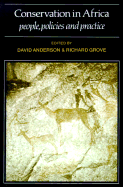Book contents
- Frontmatter
- Contents
- Preface
- List of contributors
- Introduction: The scramble for Eden: past, present and future in African conservation
- Part One Conservation ideologies in Africa
- Introduction
- 1 Early themes in African conservation: the Cape in the nineteenth century
- 2 Chivalry, social Darwinism and ritualised killing: the hunting ethos in Central Africa up to 1914
- 3 Colonialism, capitalism and ecological crisis in Malawi: a reassessment
- 4 Conservation with a human face: conflict and reconciliation in African land use planning
- Part Two Wildlife, Parks and Pastoralist
- Part Three Conservation priorities and rural communities
- Part Four Consequences for conservation and development
- Index
4 - Conservation with a human face: conflict and reconciliation in African land use planning
Published online by Cambridge University Press: 04 April 2011
- Frontmatter
- Contents
- Preface
- List of contributors
- Introduction: The scramble for Eden: past, present and future in African conservation
- Part One Conservation ideologies in Africa
- Introduction
- 1 Early themes in African conservation: the Cape in the nineteenth century
- 2 Chivalry, social Darwinism and ritualised killing: the hunting ethos in Central Africa up to 1914
- 3 Colonialism, capitalism and ecological crisis in Malawi: a reassessment
- 4 Conservation with a human face: conflict and reconciliation in African land use planning
- Part Two Wildlife, Parks and Pastoralist
- Part Three Conservation priorities and rural communities
- Part Four Consequences for conservation and development
- Index
Summary
‘Africa is on the brink of ecological collapse.’ So said a senior World Bank official at a development conference at Tananarivo in November 1985, and most people seemed to believe him. This type of belief has long given licence to government and international intervention in African rural development, and particularly to conservationist lobbies to promote a conservationist programme in Africa. The outlines of this programme are stated in the World Conservation Strategy published by the International Union for the Conservation of Nature and Natural Resources (IUCN) in 1980. The primary objectives of this strategy are as follows (IUCN, 1980):
(i) to maintain essential ecological processes and life-support systems (i.e. atmosphere, soil and water cycles);
(ii) to preserve genetic diversity (including preventing extinctions and preserving representative biotic communities);
(iii) to ensure the sustainable utilisation of species and ecosystems.
The conservationist programme is a strategy of limitation of resource use and human population increase. As such it inevitably embodies conflict between short-term individual interests and long-term communal interests. Any programme that emphasises long-term communal benefits at the expense of short-term individual benefits will meet with resistance. The problems and costs of conservation are proportional to the extent of the conflict between these two sets of interests (Bell, 1986a). For a conservationist programme to develop and survive without external enforcement, the benefits conferred must be real and they must not be long delayed.
- Type
- Chapter
- Information
- Conservation in AfricaPeoples, Policies and Practice, pp. 79 - 102Publisher: Cambridge University PressPrint publication year: 1988
- 2
- Cited by



